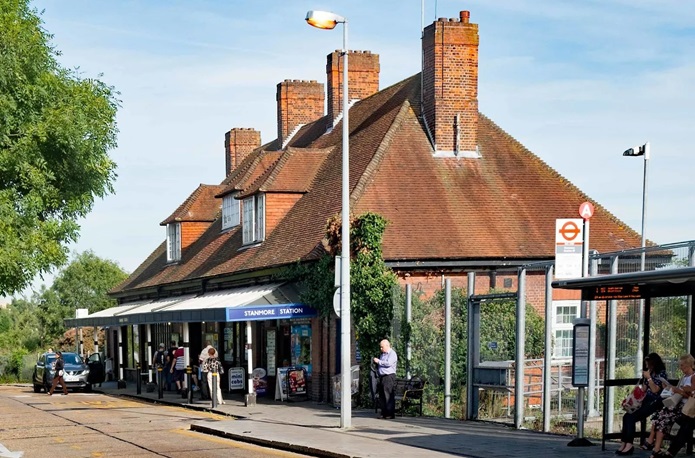Stanmore Tube Station, the Crown of the Jubilee Line.
Stanmore's first railway opened in 1890 when Frederick Gordon built a branch line from Wealdstone, to ferry guests to his country resort at Bentley priory. The station was designed in such a way to blend in with its rural surroundings, it resembled a quaint village church and stood in Gordon Avenue.
This new Stanmore station on the other hand was a purpose-built modern building, designed to fit in to the ever-growing suburbs, with the aim of taking passengers from the Middlesex countryside quickly and comfortably into London. Well, after 20 years of competition the more modern Stanmore station took the upper hand, and after Dr. Beeching had his say, It meant the permanent 'end of the line' for the old village station.
History
Metropolitan railway
Stanmore station that we know today is the terminus of the Jubilee line, but it started life as part of the Metropolitan line. The line started in 1863, connecting the city, Paddington, Euston and King's Cross and was the world's first underground railway, from there it travelled out to the leafy Middlesex countryside reaching Harrow in 1880. Thus prompting the expansion of new suburbs that would become known as Metroland or Metro land. The term was a great marketing idea from the Metropolitan Railway Country Estates Limited retail arm. The company had been banking huge amounts of land which they planned to turn into new suburbs, and they produced a brochure promoting the grandiose idea of a modern home in beautiful countryside with a fast railway service to central London.
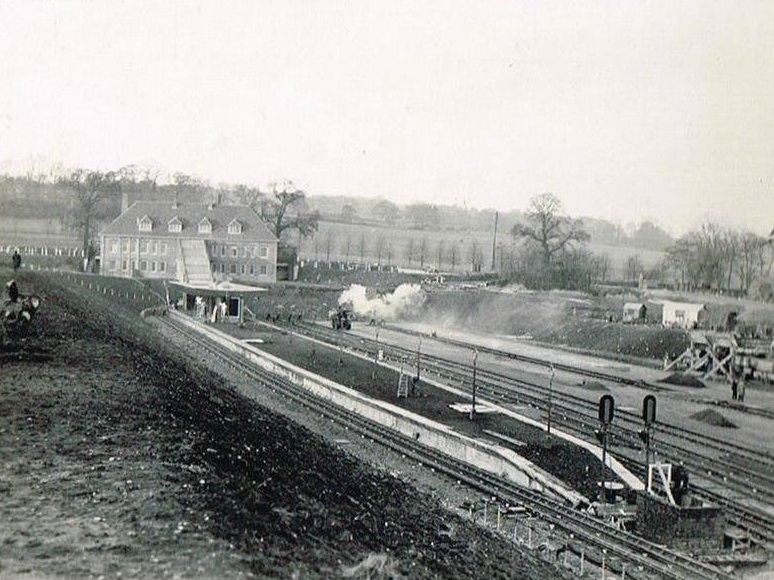
In 1929 a new branch was financed by the government, under the Development Loans Guarantees & Grants Act, which connected Wembley with Stanmore, the contractor chosen for the work was Walter Scott & Middleton Ltd and the price for the project was to be £168,628-17s-3d. They opened a works depot at Stanmore, huge amounts of earth were dug from the site to create a level area for the tracks and sidings. This surplus earth was transported down a second construction track, and used to build the long embankment through Canons Park, which was to be the the next station, a further stop was built at Kingsbury, this extention opened on 9th December 1932.
The new line was an instant success, not only could the new residents from suburbia commute in to the heart of the city, but tourist trips to London and all its attractions would now be a lot more comfortable, letting the train take the strain. Unfortunately, the original designs of the layout hadn't factored in just how popular this new service would become. Very quickly the route was suffering from congestion, caused by the limited track capacity around Finchley Road to Baker Street.
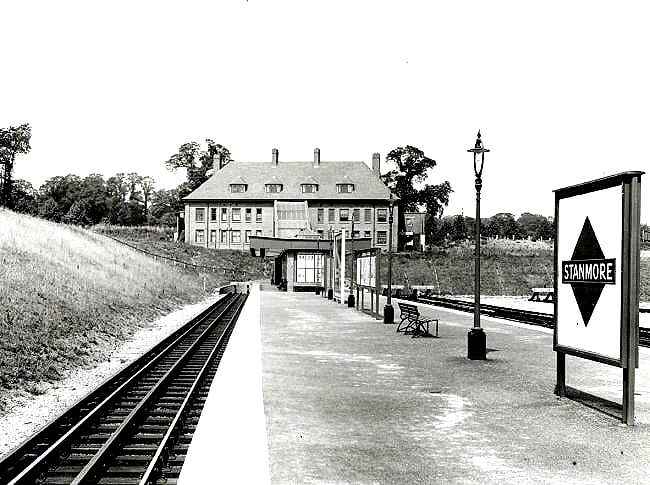
Another of London's old passenger service was the Bakerloo line. Bakerloo being an amalgamation of its original name, the Baker Street & Waterloo Railway. The line also travelled between Baker Street and Finchley Road, so new sections of tunnel were constructed, along with the replacement of three old stations and two new ones, St John's Wood and Swiss Cottage, the rest of the line as far as Stanmore station then became part of the Bakerloo line service on 20 November 1939. Stanmore would continue to be part of the Bakerloo line until the increased passenger traffic became so great that it led to the creation of the Jubilee line.
The Jubilee Line
The Jubilee line started life as the Fleet Line, the River Fleet is the largest of London's subterranean rivers and the service would have been a grandiose version of the old Bakerloo line from Stanmore to Baker Street but another 2.5-mile extension would be tagged on to extend the service to Charring Cross, which would encompass stops at Bond Street and Green Park. The lines colour would have been a drab battleship grey as in the naval meaning of the word fleet, but the then Conservative administration proposed that the service be renamed the Jubilee Line in honour of the upcoming Queens silver jubilee in 1977 and the line became the silver colour that we know today. The line was officially opened by the Prince of Wales on behalf of his mother on 30 April 1979, with passenger services operating from 1 May 1979.
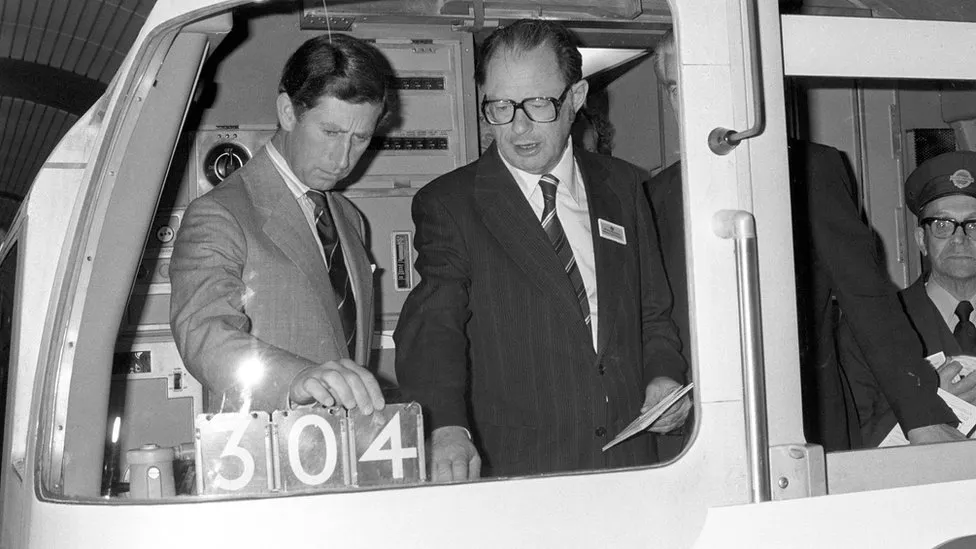
The Metro land heritage.
The Metropolitan railway was Britain's oldest underground railway system, and with that accolade had purchased the most land, buying up small holdings, scraps of land, old farms and fields that surrounded London quite cheaply, by the time that the line was operational, the railway company owned huge swathes of the Middlesex countryside. History had shown that across the world that many villages became towns after the railroads were built as their populations spiralled, by linking the urban areas to the metropolis. It was only after the railways were operational that the land increased in value. The Metropolitan company promoted their new housing estates under the Metro-Land brand, the ultimate in smart, affordable, well-built properties in the heart of the countryside with easy access to the big city.
Kerry Avenue Conservation Area
A lovely example of Metroland art deco can be seen in the roads adjacent to Stanmore station. The land was once the sprawling farm lands of The Warren house estate. Warren House, some 600 meters north west from the station, was once owned by Charles Edward Keyser, founder of the 'Colne Valley Water Company' and later the financier Henry Louis Bishoffsheim, a city banker and hospital benefactor. It was after his death that the land passed onto his grandson, Major General Sir John Fitzgerald, Irish Baronet and a Knight of Kerry. Sir John packaged up parcels of land which he sold off to construct a residential development. He appointed Douglas Wood Architects responsible for the properties built in Valencia Road, and the Architect Gerald Lacoste, took charge to build the houses on Kerry Avenue. Lacoste, was only in his 20's at the time, but had plenty of experience and, had previously designed a magnificent house for Gracie Fields in Hampstead.
Recognised as the 'earliest domestic group in west London to adopt the principals of the modern movement' These houses were constructed very much in the Modernist style of architecture, a distinct fightback against the way properties were being built at the time with pebble dashing, leaded windows and dark mock Tudor styles with oak beams. By contrast these new dwellings worked on the theory that less is more, by rejecting ornament and embracing minimalism where buildings have clean crisp lines, rounded staircase towers, and internally had large open plan interiors. The estate too follows a formal and symmetrical layout based upon the axis of the station, furnished with trees and grass verges, including an 'island' of trees and shrubs running down lower Kerry Avenue, it was described in the National Builder 1935 as: 'a charming country road entry to the pastures and woodland opposite known as the Warren House estate.'
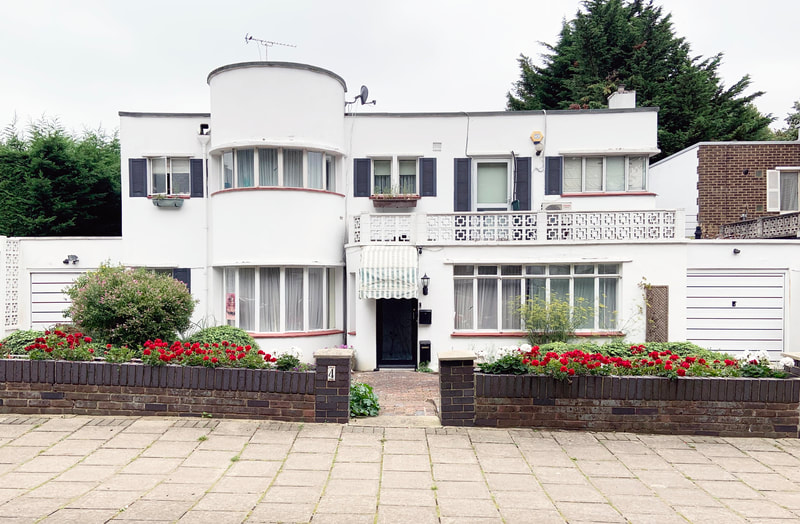
Sir Johns family seat in Ireland was 'Glanleam' which was located on Valencia Island off the coast of county Kerry, hence the three street names on the estate are, Glanleam, Valencia and Kerry. Now designated the Kerry Avenue Conservation Area, it's definitely worth a visit for admirers of art deco or modernist architecture.
Did you know:
Platform Oddity: The platforms at Stanmore station are in the wrong order. The platform numbering is a bit like a cryptic puzzle for commuters. This is because in July 2011, 70 years after the station opened, a third platform was built, in order to meet rising demand for trains. The space for the new platform was to the right of platform 1, meaning they had no choice but to ruin the order of the platforms or renumber them.
If you’re in a hurry, just remember: '2-1-3' is the secret code to avoid platform mix-ups.
Stanmore is quite well connected. The Jubilee line runs between Stanmore and Stratford in east London It's the only tube line that has interchanges with every other Underground line, including the Elizabeth line, the Docklands Light Railway (DLR), Overground and six National Rail stations.
In the 1990's when the extension was built, there were 118 escalators on the Jubilee line, the same ammount as on the whole of the rest of the Underground network put together.
Stanmore Station is definitely worth a visit. It’s a charming and historic spot in the Middlesex countryside. From here, you can explore the picturesque surroundings, including Bentley Priory and Stanmore Country Park. Whether you’re a history enthusiast or simply seeking a peaceful escape, Stanmore won’t disappoint!
